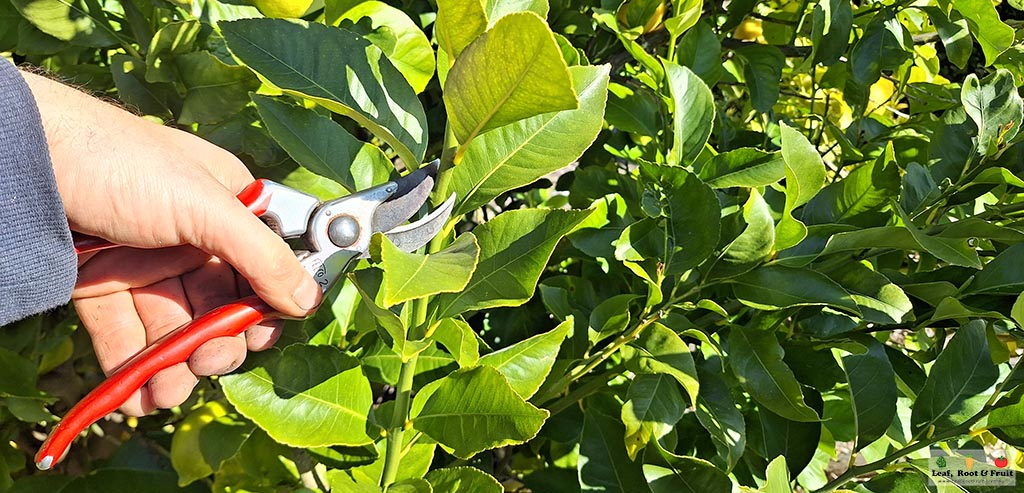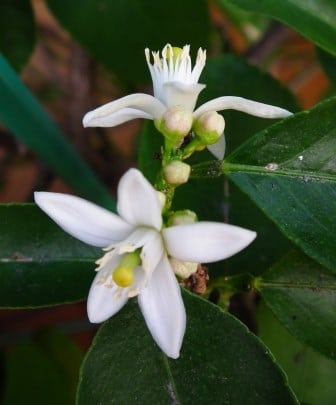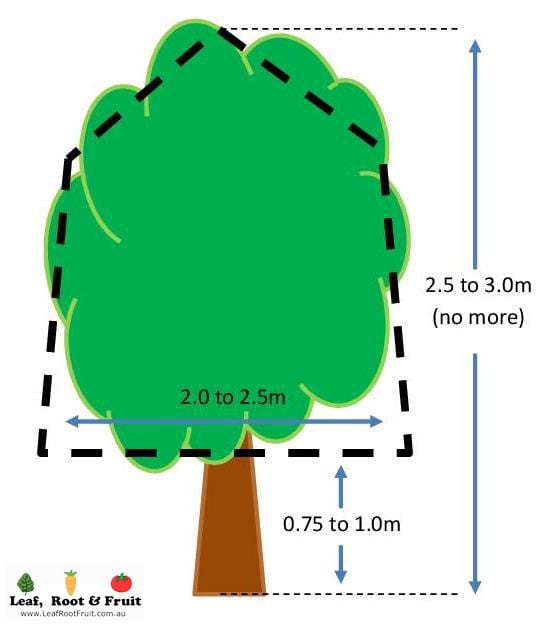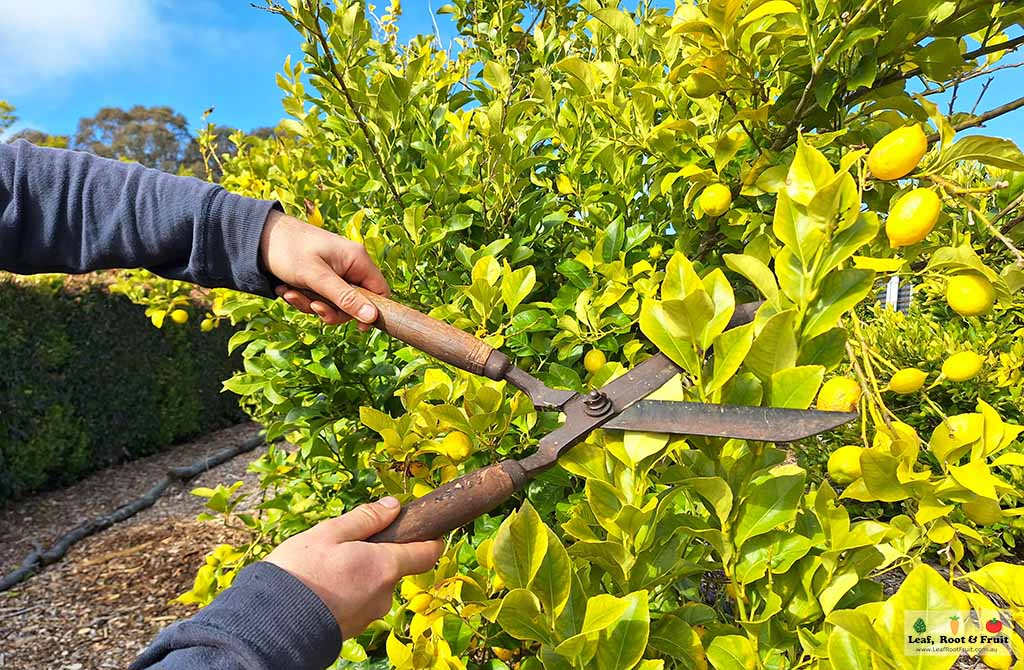
Without pruning or training, citrus trees grow naturally into bushy trees and will initially crop well. However, trees will eventually become overgrown with high proportion of dense, unproductive and spent wood. If trained, shaped and pruned in a specific way, trees will be healthier, easier to manage and will crop more reliably.
See my general guide to fruit tree pruning for information on pruning tools, pruning cuts and other general pruning information.
Citrus trees are tip-bearers. That is they blossom and produce fruit on the tips of branches. The most productive growth and fruiting occurs, in the outer 90cm of the tree canopy. So the optimum tree canopy size is no more than 2 to 3 metres. A large sprawling canopy takes up a lot of space and produces no more fruit than a compact well-managed one.
The number of terminal (tip end) shoots, determine fruit quantity. More shoot tips results in more fruit. Regulating the number of shoot terminals is the best way to achieve a balance between foliar growth and fruit numbers.

Shaping young citrus trees
Retain three to four main branches 50 to 70 cm above ground level. As the young tree grows, tip prune young shoots to keep the tree compact. The ideal shape is an upright tapering cone. Maintain this shape by tipping shoots and cutting back over vigorous water shoots in late winter. Early and continuous shaping minimises heavy cutting later on.

Maintaining the citrus tree shape
Citrus trees respond well to shaping. I usually prune them with hedge clippers. Trim any untidy growth to maintain the desired shape. The best time to prune citrus trees in Melbourne is after harvest in spring. Early pruning promotes early summer growth, that will mature before the summer heat and the arrival of pests such as leaf miner.

Check out this video to see how I approach pruning both small and large citrus trees.
Reworking overgrown citrus trees
Older, overgrown citrus trees can be reworked to the desired shape using secateurs, hedge clippers or a chainsaw.
Very old (over 25 to 30 years), weak or disease affected trees may be cut back to induce further fruiting. However, old trees like this are at the end of their productive life and are often better off removed or replaced.
Be warned, if you severely cut back a citrus tree it will respond with vigorous growth. The long, whippy growth produced after a heavy prune is called watershoots. To avoid future issues you will need to regularly tip prune the resulting flush of growth. Once regrowth has reached around 40 to 50 cm you should tip prune it. Allow a further amount of regrowth and tip prune again. This encourages branching. Continue to tip prune until the tree has reached the desired size and shape.
Citrus tree espaliers
Citrus trees can be trained into an espalier. Citrus trees are tip bearers. Therefore, they are best suited to an informal green wall espalier shape. See my guide to fruit tree espaliers for more information on this.
Want to know more about Growing Citrus in Melbourne?
This is Part 4 of a 5 part guide to growing citrus in Melbourne. The links below will take you to the other four parts of my Melbourne citrus growing guide.
Citrus Growing Guide Part 1: Citrus Varieties for Melbourne
Citrus Growing Guide Part 2: Where and How to Plant Your Citrus Tree
Citrus Growing Guide Part 3: Ongoing Care and Management of Citrus Trees
Citrus Growing Guide Part 5: Citrus Pests, Diseases and Problems in Melbourne
My citrus growing guides are based on my own experience, as well as the following books. They are all invaluable resources for the home gardener based in Melbourne. I strongly recommend you have a read of them, if you want to know more about growing citrus in Melbourne:
Ian Tolley: Commonsense Citrus, 2017
Bruce Mophett & Ian Tolley: Citrus, A Gardener’s Guide, 2009.
Louis Glowinski: The Complete Book of Fruit Growing in Australia, 1997.


I have a Lisbon Lemon tree which is about 12 years old. Had a lot of trouble with Gall wasp and was advised to cut tree back vigorously.
This was done about 2 years back and Gall Wasp is not present. However the problem now is I have a very health looking lemon tree that will not produce fruit. Further, the small amount of flowers were not at all productive and did not last long before falling off.
I am thinking of removing the tree and replacing it.
Should I replace the tree or try giving it another prune?
Hi Brian,
Thanks or your question. I’d give it one more year. It would take the tree some time to respond to a severe cut back. Citrus produce flowers (and fruit) on terminal buds, ie the tips of branches. So make sure that there’s as many tips as possible with an occasional tip prune (hedge trimmers are great for this). Please keep us updated on progress.
Good Luck!
Duncan
Hi, great articles. I have a young lime tree which is about 1 metre in height. Problem is it has a main trunk but no branches. Could you please tell me the best method to promote branch growth?
Hi Rod,
To promote branch growth, simply prune the trunk just above where you’d like the branching to start. Doing so removes the apical meristem, which is the growing tip and produces a hormone called auxin. Auxin prevents lateral branching, so by removing the source of the auxin, you will allow branching to occur.
Good Luck and Happy Gardening!
Duncan
Hi Duncan, We planted a Tahiti lime tree five years ago and it’s about 2m and vigorous. It’s on quite sandy soil. Last year it produced about 150 juicy limes and this year about 10. Ifertilised it with citrus fert in October and Dec and it has been watered regularly. How can I get more fruit please?
This is a great site!
Cheers Mike
Hi Mike,
It could be several things, and without seeing the tree, it’s hard to say. However, the most likely reason is that the tree has entered a biennial cropping pattern. It’s quite common in citrus (and many other fruit trees). When a tree has an overly productive year, it takes a lot of energy from the tree’s reserves. So the next year it often decides to take a year off. It’s a bit like asking someone to work 10 hour days, 7 days per week. At some point they are going to want a holiday. The best way to avoid this is to thin fruit in the productive years to a load more manageable by the tree. Unfortunately (especially with lemons) once the tree is in this biennial cropping pattern, it can be very hard to reverse. I’d expect your tree to have a bumper crop again next year, and I’d give thinning the fruit a shot to try and stop a poor crop the year after that.
Please let us all know how you get on!
Duncan
Hi Duncan, I picked the last of my navels a few weeks ago and I was hoping to give the tree a trim but it has started producing an abundance of flower buds. Can I still give the tree a trim or would I be cutting off next year’s potential fruit yield? (I need to remove quite a bit of gall wasp damage).
Kind regards,
Lee
Hi Lee,
Thanks for your inquiry. You should be fine to give it a trim now. I fond that even if you cut off a lot of the flower buds with a tip prune, it will often quickly re-flower. However, it may still result in a lower yield next year. Especially if you are taking out entire branches (which I don’t recommend). With regards to gall wasps – it might be worth having a read of this article that I recently wrote: https://www.leafrootfruit.com.au/citrus-growing-guide/treating-citrus-gall-wasp-melbourne/
Good Luck and Happy Gardening!
Duncan
Thanks, Duncan!
Pruning for the “not so bold” is not easy or a naturally obvious process.
I’d think an actual “watch me do it” video would be extremely helpful.
Thanks for the feedback Peter. I’ll add it to the “to-do list” and see if we can put one together for you.
Good Luck and Happy Gardening!
Duncan
have a mandarin tree emperor , had it for about 5-6 years ,the ground is slightly down or slanted, had some black underlay for weeds and have put some rocks around it always fed the tree with citrus food sparling, been to a few garden places showed them the fruit and check the soil , fruit always dry but plenty of fruit and plant very healthy shown them a photo of the tree, been watering it about 3-4 time a week in summer , the water just ran down , the gardeners told me , to have the land slightly downwards is good because of drainage. we have found the soil was very compact and maybe soil need to be more aerated it has no clay and acid and nutrients was good acid about 6.0 ph, and to put some sheep manure a about 3 bags around the tree and work it abit. the tree is now established so to be careful. also i was told that the soil should have worm in the soil whish is a good indicater. .
In the last 8 months have changed the soil with sheep manure, loosen the soil, removed the rocks around it , put some wood to hold the water longer ,prune it end of january 2018 and now the tree seem to lose most of its fruit or nearly all, and leaves fair bit. am i over watering it and put more citrus food. this tree seem to confuse me .i have a washington orange tree l give it food and nothing else and it gives me plenty of fruit.
Hi Leon,
When a citrus tree loses leaves and or fruit it indicates that it is stressed. This could be for a variety of reasons, some of which you have mentioned. It could be because of too much water, not enough water, too much fertilizer, not enough fertilizer, wind, heat stress, cold stress. We’ve had a very dry February and March. Which has stressed a lot of citrus trees and caused them to loose leaves. Without seeing the tree and the site, it’s difficult for me to say what’s causing the issue. Perhaps you should treat the tree more like the Washington Naval?!!!!
Good Luck and Happy Gardening!
Duncan
I live in Coffs Harbour NSW which has a ‘sub’ tropical climate and this year we have enjoyed beautiful sunny and warm late winter days. As a result my 4 year old Eureka lemon tree has shown vigorous early growth and prolific budding. I am therefore treating it as early Spring and started citrus fertilising (Yates liquid). It has never looked healthier but is shooting new growth at the top which will develop into spindly branches from 0.5 to 1 metre tall if left alone. I intend to prune these shoots back to keep the tree shape plus divert the energy to flower and fruit growth. Is this the correct practice? I am pleased with the tip budding of the main bush and expect a very good yield providing the buds set.
Hi John,
Thanks for your comments. It sounds like you are on the right track!
Good Luck and Happy Gardening
Duncan
The information is very useful. In pruning of Lemon it is an art when comparing Mango and other fruit trees since it gives yield more than once a year.
It is very difficult for us to remove small water shoots inside the tree. Can you suggest a opt tools for removing them.
Hi KK, I would just use secateurs!
I have a very tall and narrow kaffir lime tree sapling, probably about 2 feet tall, limited to a single stalk. I assume it came like this for shipping purposes. What would you recommend to encourage it to branch out? Thanks!
Hi Erik,
You need to prune the branch back to wherever you want it to branch out.
Hope that helps
Duncan
I have skeleton pruned of an old and until recently hyperproductive lemon tree.No galls left here. The plan is to reinvent our lemon as a smaller more accessible fruiter. However the tree now has large exposed cuts. I am concerned that the tree, shocked, may be susceptable to infection or infestation. IS there a post traumatic salve recommended? A spray? to protect its wounds!!
Hi Terese,
The old days of sealing wounds with tar are long gone. Trees tend to heal best when left to do it themselves. Large cuts certainly make the tree very susceptible to disease and rotting. So best to avoid heavy pruning unless absolutely necessary.
Good Luck & Happy Gardening
Duncan
I have seen lemon trees pruned in a trelis style so the tree more spread out rather than a bush. Is this possible with a dwarf variety grown in a pot?
Hi Mishy, it is possible, but the tree will be very small. It would be better to use a tree on Trifoliata rootstock as it will grow faster, fruit faster and generally be a larger specimen. The pot will restrict the tree anyway and keep it from getting too large.
Thank you for your very very comprehensive guide. I’m finding your work interesting and useful and it really is such a lovely researched sharing.
Hi Sally,
Thanks for your very kind feedback. I’m glad you find it interesting.
Happy Gardening!
Duncan
Hi Duncan,
Hope you are well.
I bought a Valencia orange tree a few years ago, a bit over a metre tall, and planted it in the back garden. It seemed to be doing well, green leaves and continued to grow. But I changed my plan for the garden which meant the tree would not “fit” by the time it reached its mature size – the label says 6-8m high x 6-8m wide. So I decided to dig the tree up, potted it, and replaced it with a dwarf Valencia last year, which is only supposed to grow to about 2m x 2m. It also seems happy but it’s currently only about 80cm tall. Compared to its bigger, bushier predecessor, which is now about 1.5m, it does look very little – with a lot of exposed garden fence behind it.
What I wanted to ask is do you know how long orange trees take to reach something like full size? The bits and pieces I found online suggest they are quite slow-growing and this can take 10+ years. So I’m wondering whether I should just be patient with my dwarf or – having read your post above on keeping orange trees pruned to a small size – should I put the bigger, original, orange back where it was and keep it pruned. The dwarf tree could go in the pot instead.
Any ideas appreciated,
Chris
Hi Chris, I tend to avoid planting dwarf citrus. They are slow growing, stay small and are not overly productive. A full sized tree can easily be kept to 2 x 2m via pruning. If you can be bothered then yes, try swapping the trees back over again. You’ll have better success in the long run.
Good Luck & Happy Gardening
Duncan
I have an old Maltese blood orange that thrives in Melbourne (30yrs old) but is not too sweet, I also have 2 Arnold blood oranges purchased from 2 different nurseries funny thing is they produce different fruit. One tree has bigger sweeter more coloured fruit than the other. I also have a blood orange grown from a seed whose fruit was almost black with colour, this healthy tree about 2m high and about 7 years old and i’m doubtful if I’ll ever get fruit from it, if it stay infertile its going to be grafted with scion from my better Arnold or maybe a mandarin or maybe a lime or all of the above – it might become my citrus ‘”salad” tree. I also have Eureka lemon which is 36yrs old and pumps out more lemons than 3 families can use.
I live in Craigieburn with heavy clay just beneath the surface so I’m grateful for the successes ive had so far
Hi Joe,
Thanks for sharing your experience with us. It sounds like you’re having some great success with your citrus experiments.
Good Luck & Happy Gardening
Duncan
I have a Dwarf Lemon tree and a Dwarf Grape fruit tree the grape fruit gets really big fruit on and is covered with lovey healthy leave the lemon tree gets small fruit but the branches are thinner what can I do to fix this problem
Hi Chris, a grapefruit is a very vigorous tree compared to a lemon. It will always grow at around twice the rate of the lemon tree and be around twice as big. The only way to “correct” this is to prune the grape fruit tree much harder than the lemon.
Hope that helps you to understand what’s going on.
Duncan
Can I fix an overgrowth of sucker roots. Fruit is useless. I got sick and couldn’t trim and dig down to sucker
Hi Judy,
You’ll need to keep pruning back the rootstock suckers. Ideally find where they are shooting from the roots and cut them off cleanly so that it doesn’t leave a stub.
Good Luck & Happy Gardening!
Duncan
Hi, I have a tahitian lime tree that had a disease (weeping sap from the main trunk). I cut the main trunk basically in half to remove the area with the disease. I was wondering will this tree every grow in height or have I stunted it? The top face of the main trunk looks to be dried out but everything below it is healthy and continues to shoot and flower.
Hi Aaron,
It sounds like Phytophthora Gummosis or collar rot. This has probably occurred due to poor soil drainage and/or not enough airflow around the trunk of the tree.
If the tree recovers from the disease then it should grow back ok. But if the underlying cause is still present (eg long grass around the trunk or waterlogged soil) then the tree will likely die within a year or so.
Best of luck with it
Duncan